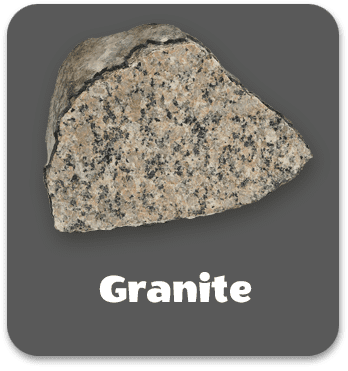If Rocks Could Talk
Sandstone

Rondi: I'd like to introduce Sandstone. Sandstone is a red, sandy sedimentary rock . It hails from the Catskill Mountains in New York. About five years ago, it was reunited with a long-lost cousin from Scotland, a similar piece of sandstone. The two were brought together here at the Museum after 200 million years apart. The story of their separation is really a story about Earth's history. Sandstone, thanks for talking with us today.

Sandstone: It's my pleasure, Rondi. I feel it's important that the world hear our tragic story. It is a story of heartbreak. A story of separation. A story of ... family. (Sniff.) You'll have to forgive me. I always get a little choked up when I talk about this.
Rondi: Why don't you tell us about where your family came from?
Sandstone: Ah, the good old days. Well, my family is known as the Old Red Sandstone. We started to form about 400 million years ago. I don't have to tell you, the world was a different place back then.
Rondi: How so?
Sandstone: It was a totally different planet. Now, you might be thinking: "Oh, there weren't cars back then." Well, let me tell you. There weren't even people. In fact, there wasn't even a North American continent. There was just one "super-continent."

Rondi: You mean" Pangaea "?
Sandstone: That's the one. Anyway, about 400 million years ago, mountain ranges started to form in my old neighborhood of Pangaea.
Rondi: Are any of those mountain ranges still around?
Sandstone: Yes. Today, two of these are still around: the Appalachian Mountains in the U.S. and the Caledonian Mountains in Europe. As those mountains formed, sand, silt, tiny pieces of rock, and other sediments washed into the water between the two mountain ranges. These sediments sank to the bottom and, over time, formed layers and layers of sediments, one on top of the other. As the layers grew thicker, they became squeezed and cemented to form sandstone.
Rondi: Right. And you were part of a huge area of reddish sandstone called "Old Red Sandstone." Why don't you tell us why you're red?
Sandstone: Oh, you mean my healthy red glow? The color of sandstone depends on the chemicals in the sand it's made from. When there's a lot of iron, it turns rusty red - like me! And I may be old for sandstone but I'm not that old. There are rocks at the Museum that are much older than I am!
Rondi: Now, you still haven't explained how you and your cousin from Scotland ended up on two different continents.
Sandstone: That was a sad time in my life, Rondi. This is how it all happened. Earth's rocky surface is split into huge pieces.
Rondi: You mean " tectonic plates "?

Sandstone: Yes! It's all because of them that this happened! As you know, the tectonic plates float on the mantle, a layer of hot solid rock just below Earth's crust. The mantle is always moving, which causes the plates to move. When the plates move, they cause mountains to form, volcanoes to erupt, earthquakes to shake ...
Rondi: And continents to move?
Sandstone: Yes, they even cause continents to move. About 200 million years ago, the tectonic plate that we were sitting on broke, and the two pieces separated from each other.
Rondi: That must have been what caused the continents of Europe and the Americas to separate.
Sandstone: Yes ... (sniff) ... and the Old Red Sandstone family was separated, too. For millions of years, we've been divided by the Atlantic Ocean. But I never forgot them ...
Rondi: So, how did you and your cousin get back together?
Sandstone: Fate? Luck? Actually, it was the American Museum of Natural History. Their scientists collected us for the Gottesman Hall of Planet Earth exhibition.
Rondi: Did it take a while for you to recognize each other?
Sandstone: We had changed a bit. After all, a lot of time had passed. But we recognized each other right away. You just never forget family.
Rondi: I'd love to see a picture of your cousin. Do you happen to have ...

Sandstone: Of course I do! Look at that gorgeous rock.
Rondi: Ah, I can see the family resemblance. Thanks for sharing your family's story with us today.
Sandstone: Oh, it was lovely speaking with you, Rondi.
Image Credits:
Photos: All images: courtesy of AMNH




 Biodiversity
Biodiversity
 Brain
Brain
 Genetics
Genetics
 Marine BiOLogy
Marine BiOLogy
 MicrobiOLogy
MicrobiOLogy
 PaleontOLogy
PaleontOLogy
 ZoOLogy
ZoOLogy
 AnthropOLogy
AnthropOLogy
 ArchaeOLogy
ArchaeOLogy
 Astronomy
Astronomy
 Climate Change
Climate Change
 Earth
Earth
 Physics
Physics
 Water
Water






